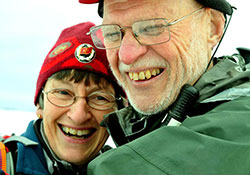Physical activity after 80 in Stockholm, Sweden

WHO/Malin Bring
With a life full of physical activities, academic studies and frequent socializing with friends and family, 80-year old Lars Lemby has no time to worry about growing old. In the affluent Swedish capital of Stockholm, he forms part of a trend. Well-educated and active older men live rich and long lives in the Stockholm region.
The sky is overcast and the temperature hovers around minus ten degrees Celsius. At the edge of the snow-covered archipelago, Lars Lemby and two of his skating friends are getting ready for a day's gliding across the frozen waters. "You see this rucksack I'm wearing? It doubles as a life jacket, and always contains an extra set of dry clothes in case I should fall through the ice," he explains.
Long-distance skating is a passion he practices as often as possible during the winter season, besides training at a gym and going to gymnastics twice a week. In the summer the energetic senior gets most of his exercise from gardening."I'm much more physically active now than when I was working, as a matter of fact. To me, a day without any physical activity is a wasted opportunity."
Having donned the two ice claws – another piece of compulsory safety equipment – on a string around his neck and positioned the ice pike – a tool that allows him to test the strength of the ice – firmly in one hand, Lars Lemby sets off with long, confident strides together with his friends. In no time the little formation of skaters has diminished into tiny silhouettes against the grey horizon. There is no way of telling that the little figure in the lead has in fact passed the age of 80.
Socioeconomic determinants of healthy ageing
"On the whole, the elderly population of Stockholm leads a good life and has healthy habits, but there are big discrepancies between different socioeconomic groups," says Neda Agahi, researcher at the Stockholm Gerontology Research Centre.
Life expectancy in the capital is rising, in recent years even faster among men than among women, but the well-educated and privileged groups have a healthier lifestyle and live far longer than their less fortunate contemporaries. "There can be as much as a five years difference in life expectancy between people from disadvantaged areas and people from the most prosperous municipalities," says Neda Agahi.
Long-term benefits of good practice
The day after his skating trip, Lars Lemby is relaxing at home with his wife, Anna-Maria, with whom he has been married for 57 years. The couple live in an airy villa in one of Stockholm's more well-to-do areas. Despite their age, they receive no form of help or care from the municipality, and have never asked for it. "When I turned 80 I received an information packet from the authorities about what kind of help we are entitled to in our old age. So far we haven't seen the need to make use of it, though," says Anna Maria.
They both like to travel and socialize with their circle of friends, and two of their three children live nearby. Lars Lemby also busies himself with studying at a Senior University, and has plowed through a host of subjects, from astronomy to religious studies.
When asked what advice he would give on cultivating a good life in old age, Lars Lemby does not hesitate: "Be physically active, see your friends and family often, and make sure you have many nice interests and hobbies. It's the same advice I would give to a person of any age."



